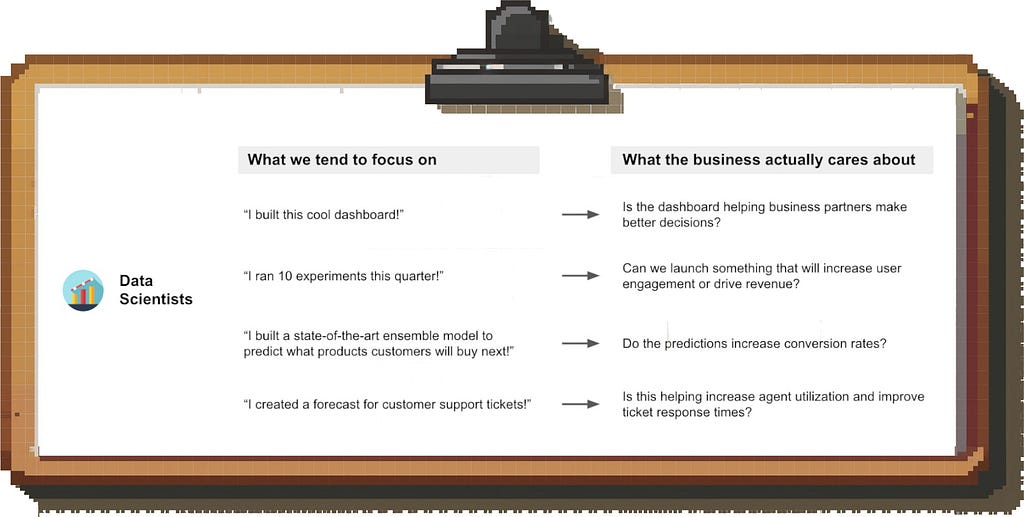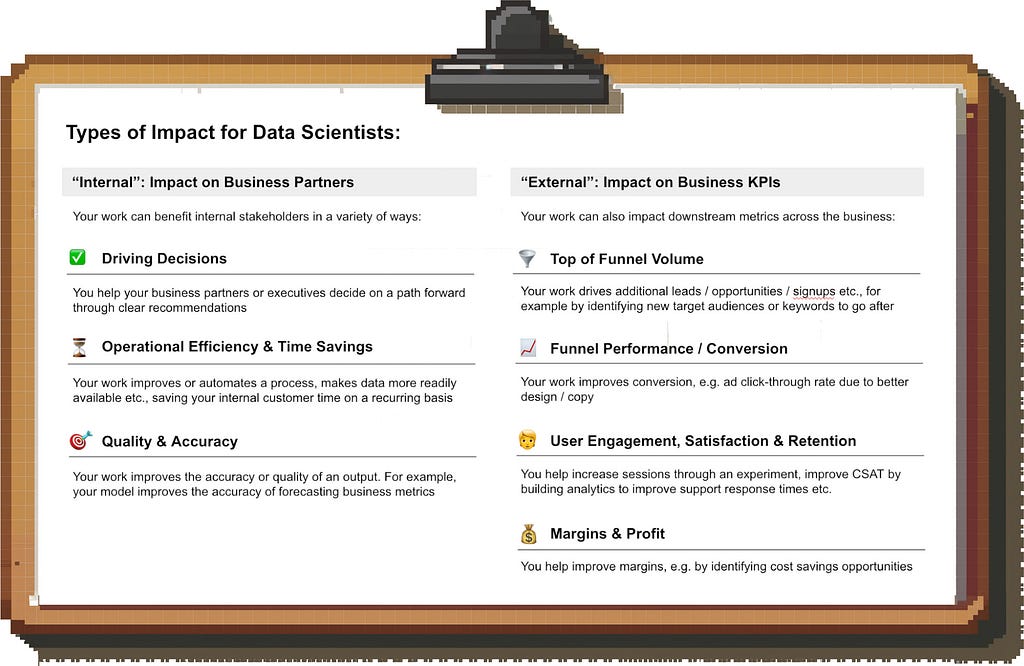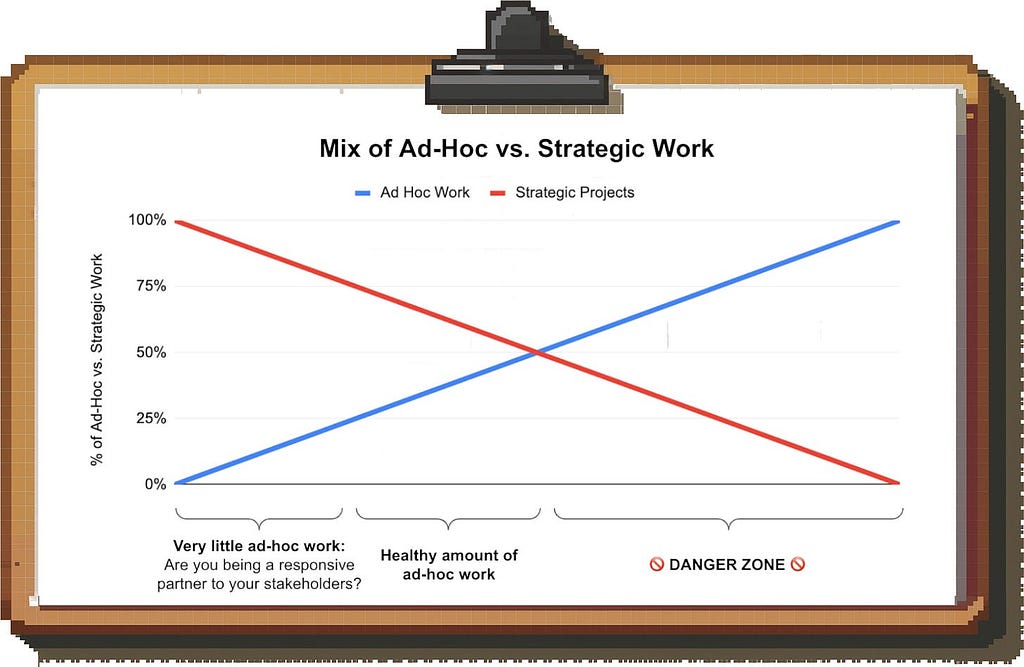
Actionable advice to accelerate your career

One of the hardest pills to swallow as an Individual Contributor (IC) at work is that nobody cares about the hard work you put in. They don’t even care about your output; they care about the impact you drive.
What’s the difference? Your output is the analysis you deliver, or the lines of code you write. Your impact is the decision your analysis helps the CEO make, or the revenue the new product feature is generating.

If you want to establish yourself as a high performer and accelerate your career as a Data Scientist, it’s key to focus on impact.
In this post I’ll go over the following:
- Why prioritizing impact matters not just for managers, but also ICs
- Why focusing on impact is hard
- How to maximize your impact
- How to overcome common challenges in driving real impact
Let’s dive in.
Get an email whenever Torsten Walbaum publishes.
Why should I focus on impact; isn’t that my manager’s job?
Of course you can leave it to your manager to worry about impact. But stepping up comes with some real benefits for your career:
- Reduced frustration & burn-out: Putting a lot of work into a project and then feeling like it didn’t move the needle is one of the most frustrating feelings in any job.
- Promotions: Promotions are heavily tied to impact. And if you want to become a manager, you’ll need to show that you understand what drives business outcomes and can allocate resources accordingly.
- Internal opportunities: People around you notice if you are having an outsized impact, and you’ll increase your chances of receiving internal offers. My promotion to Director happened because the CMO noticed my work on the BizOps team and asked me to move into the Marketing org to build out a Strategy & Analytics team.
- External opportunities: Prospective employers don’t focus on what responsibilities you had, but what your impact was. After all, they are trying to figure out how you can help their business.
Why isn’t everyone doing this?
Because it’s hard.
We are used to thinking about inputs and outputs rather than impact in our daily lives (“I went to the gym” or “I did three loads of laundry”) and we carry that mindset over to our jobs.
More importantly, it gives us a sense of control. It’s fully under your control to work hard on the project, and maybe to create the final deliverable, but you can’t guarantee that it will actually move the business forward.
It can also feel like we’re doing someone else’s job. You built the dashboard; now it’s the other team’s problem how they’re going use it and get value from it. You can definitely take this stance; but don’t you want to see your work move the needle?
Lastly, sometimes it’s unclear what impact even looks like for our role because we feel too disconnected from the business outcomes; I’ll get into this below.
How can I become more impact-focused?
Step 1: Understand what impact looks like for your role and measure your success accordingly
Stop thinking about productivity metrics like “I launched 5 experiments” or “I built this model” and hold yourself accountable to driving impact.
But what does that look like for a Data Scientist? For other roles it’s easy; Account Executives have sales quotas and Growth Marketing Managers have lead generation targets.
But Data Science, at its core, is a function that supports other teams. As a result, there are two levels of impact:

Did your work change anything for the better for your business partners? E.g.:
- Did your analysis change the roll-out strategy of the new product?
- Did your model improve forecast accuracy?
- Does your dashboard save the team hours every week that they used to spend on manual data pulls?
Did your work help move the needle on downstream business metrics? E.g.:
- You’re a Marketing Data Scientist? Assume you’re on the hook for hitting lead and opportunity targets, and improving Marketing efficiency
- You’re doing Analytics for the Customer Support org? Start obsessing about response times and satisfaction scores.
You don’t have to be solely responsible for something in order to take (partial) credit for it. If you provided the analysis that resulted in a pricing change that saved the company millions, then you deserve part of the credit for that impact.
You might not feel the consequences of missing these downstream targets as immediately as your stakeholders, but since your long-term career trajectory is still tied to driving impact, it helps to adopt this outcome-focused mindset.
Once you start doing this, you’ll notice more inefficiencies you can help address, or new opportunities for growth.
Step 2: Ensure your work solves a real business problem
You’ll likely know this situation: Instead of approaching you with a problem, people ask you for a specific deliverable. An analysis, a model, a dashboard.
If you blindly execute what they ask, you might realize too late that it won’t lead to tangible business impact. Maybe the problem they are trying to solve is not that important in the grand scheme of things, or there is a better way to approach it.
So what can you do?
Act like an owner. Understand the actual problem behind the request, and ask yourself what business priority this supports.
If you are early in your career then your manager should ideally help with this. But don’t rely on this: Managers don’t always do a perfect job, and you’ll be the one to feel the consequences of badly scoped work.
This requires you to understand company level priorities and the priorities of other orgs and teams. Take notes during All Hands meetings etc. to understand the big picture, and get your hands on other team’s planning materials to get an idea of what they’re trying to accomplish in the next 1–2 quarters.
Step 3: Ensure there is buy-in for your work
Even if your work directly supports company-level priorities, you’ll be in for a bad time if key stakeholders are not bought in.
You don’t want to be in a situation where you finish the work and then realize that another team is blocking the implementation because they have concerns you didn’t address. To avoid this, you’ll:
- Need to understand whose support you need, and
- Get them onboard from the get-go
This is a complex topic in itself; I’ll write a separate deep dive on how to drive alignment and get buy-in from other teams in the near future.
Step 4: Focus your time on the highest-impact thing
No matter what role you’re in, you’re likely juggling multiple priorities. To maximize your impact, you need to ensure you spend the majority of your time on the most important thing.
As with many things, this is easier said than done though, so let’s talk about what that looks like concretely.
Ad-hoc requests vs. strategic work
It’s easy to get caught up in the craziness of daily business only to realize you didn’t make any progress on the big, strategic project you actually care about.
This is all too common; none of us get to sit in our ivory tower and chip away at our projects undisturbed. Plus, ad-hoc work is impactful, too; while it’s less exciting than strategic projects, it’s what keeps the business running.
Still, if you find yourself spending the majority of your time fielding these ad-hoc issues, it’s time to talk to your manager. I’m sure your manager would rather help protect your bandwidth than have you 1) miss your deadlines on your key projects and 2) quit eventually from frustration.

Don’t cry over spilled milk
Another common challenge comes from the sunk cost fallacy. You invested a lot of time into a project, but it doesn’t seem to be going anywhere. Maybe you realized the premise didn’t make as much sense as you thought, or the priorities of the business have changed since you started the work.
Instead of talking to your manager and stakeholders about changing the scope of the project or abandoning it altogether, you’re doubling down to get it over the finish line. After all, you don’t want all of your effort to go to waste. Sound familiar?
Economists (and Poker players) figured out a long time ago that this is a dangerous trap. When prioritizing your time, ignore how much effort your already put in and focus on where the next hour of work will yield the most impact.
Things to watch out for (“impact killers”)
How do you minimize the odds of wasting time on a project that won’t lead to impact? There are a few warning signs:
- “Academic” projects: Any time a project is pitched to you along the lines of “This would be interesting to understand” you should be careful; projects that purely improve the understanding of an issue without tying it back to the business are a waste of time and source of frustration in my experience
- Overly ambitious project scope: At Uber, everyone always wanted to understand what the “best” driver incentive type is. Many people worked on this over the years, but it never led anywhere. There was no simple “one-size-fits-all” answer to this question, and the projects that led to actual impact were much more concrete, tactical optimizations
- The customer or deliverable are not defined: If it’s not clear who the end user of your work is (are you doing this for your manager, leadership, or another team?), or you’re unsure what exactly you’re supposed to deliver, it should raise a red flag. This is typically a sign that the project needs more scoping work before someone should start running with it
Common Challenges and How to Address Them
We talked about general frameworks to maximize impact. But how do you make actual, specific projects more impactful?
Many times, projects fail close to the finish line. Impact doesn’t materialize automatically, so you need to put in the final bit of work to ensure your work gets adopted. Doing this has an extremely high return on the time you invest since you already did the hard work to produce the deliverable and “only” need to close the loop with stakeholders.

To make things more tangible, I am going to go through a few types of common deliverables, touch on where they typically fail to create impact and propose what you can do about it:
1. You create a comprehensive analysis but nobody is acting on it
Problem: This is common with analyses that don’t have a clear recommendation. If you simply outline the data and potential paths forward, you are expecting your audience to do all of the heavy lifting.
Solution: Your work starts adding real value for them once you take that work off their plate. Always give a clear recommendation; you can caveat it and show alternatives in the appendix, but you need to take a stance.
2. You ran an experiment but nobody is using the results
Problem: Many experiments conclude with a metrics read-out by Data Science. More often than not, this is a “metrics dump” with a lot of information, but little interpretation or context.
Solution: Help your business partners interpret the results, and tell them how it affects what they care about.
- How should they think about the statistical significance or lack thereof?
- Is the observed lift good compared to other changes you tested and shipped?
- What is your recommendation for next steps? What does the experiment result mean for this person or team specifically?
Remember, you are the subject matter expert and shouldn’t expect non-analytical audiences to interpret raw experiment data. Telling your stakeholders what the result means for them will increase chances they will act on it.
3. You built a predictive model, but the team you built it for is not using it
Problem: When predictive models don’t get used, it’s often because of a lack of trust in the model output.
ML models themselves tend to be black boxes, and if teams don’t understand how the outputs were generated and whether they are reliable, they are hesitant to rely on them. Even if your model is not using ML and lives in a spreadsheet: If people don’t know how it works, they’ll be suspicious.
Solution: It’s all about involving stakeholders in the process and building trust.
- Involve stakeholders in the model development from the get-go to get them comfortable and address any concerns early on
- Demystify the output; for example, you can extract the top model features and explain them
- Sanity-check predictions and compare them to intuition. For example, if you forecast sales but your model predicts a different seasonality pattern from previous years, you’ll need to be able to explain why, or you’ll lose trust. In my experience, this is more impactful than just sharing performance metrics like the accuracy of the model
Having a structured playbook for how to do this will make your life easier, so I’ll cover this in a separate post in the near future.
4. You created a dashboard but nobody is looking at it
Problem: If a dashboard doesn’t get used, it’s likely one of these things is true:
- The dashboard doesn’t directly address an urgent business use case
- You didn’t involve your stakeholders along the way (e.g. by sharing mock-ups and drafts for feedback) and the final product is not what they were hoping for
- The dashboard is complex and your users don’t understand how to get what they need
Solution: To address #1 and #2, start with user research to understand pain points and potential use cases of the dashboard, and involve your stakeholders during development.
With regards to #3, a simpler dashboard that users are comfortable with beats a more advanced one that doesn’t get used. If you cannot (or don’t want to) simplify the dash further, you’ll need to train your users on the functionality and shadow them to understand any points of friction.
A dashboard is not done when you ship it for the first time, but needs to be improved over time based on users’ needs and feedback.
Closing Thoughts
Focusing on impact is scary since we leave the world of controllable inputs behind, but it’s what ultimately gets you promotions and new job opportunities.
And isn’t it nice when your work actually feels like it moves the needle?
For more hands-on analytics advice, consider following me here on Medium, on LinkedIn or on Substack.
How to Maximize Your Impact as a Data Scientist was originally published in Towards Data Science on Medium, where people are continuing the conversation by highlighting and responding to this story.
Originally appeared here:
How to Maximize Your Impact as a Data Scientist
Go Here to Read this Fast! How to Maximize Your Impact as a Data Scientist
